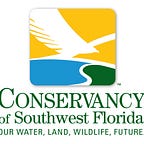Wood Stork, Special Delivery!
by Jennifer Bobka, Conservancy Naturalist II
Perhaps you have seen one of these rather peculiar looking birds scrounging for fish along a roadside canal. What a noteworthy sight to behold! Not only are these fascinating birds the only storks in the United States, but they were recently swooped off the cliff of endangerment, branding them a conservation success story!
Contrary to uncommon belief, the wood stork’s head is not actually made of wood; while adults have no feathers on their necks or heads, the name more comes from the wooded habitats in which they build their nests.
Wood storks can be found wading in canals, swamps, ponds and marshes. In these shallow waters, they sweep their open bills from side to side- a technique known as “tactolocation.” Once a fish is felt, the bill SNAPS shut, arguably faster than any other vertebrate! A breeding pair of wood storks may consume over 400 pounds of fish in a single breeding season. How’s that for a gluttonous holiday?
Much like a hefty share of the Florida population, wood storks are merely seasonal visitors to the Sunshine State. They have been returning in greater numbers since being federally downlisted from endangered to threatened in 2014, in large part due to the Everglades Restoration Project restoring the natural flow of water, resulting in a greater abundance of food. Unlike their human counterparts, wood storks will not breed if sufficient food is not available.
While, in modern times, wood storks seem to have relinquished their baby delivering duties, they are still hard at work- and under threat- creating their own. So the next time you are lucky enough to be graced by the presence of one of these magnificent and unique creatures, give a tip o’ your hat to the old chap!
Come check out the wood storks and other wildlife at the Conservancy of Southwest Florida’s Nature Center, #69 on the Great Florida Birding Trail! https://www.conservancy.org/nature-center/plan-your-visit
